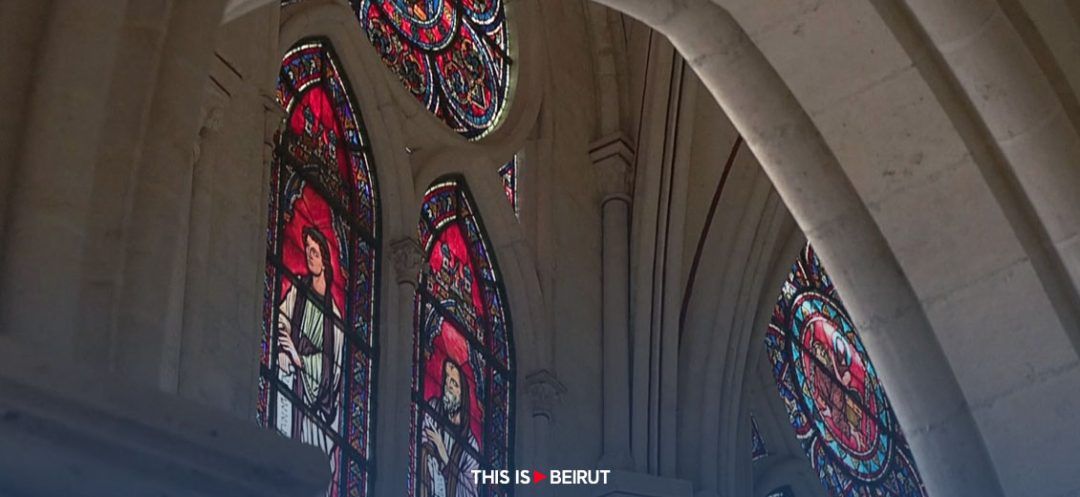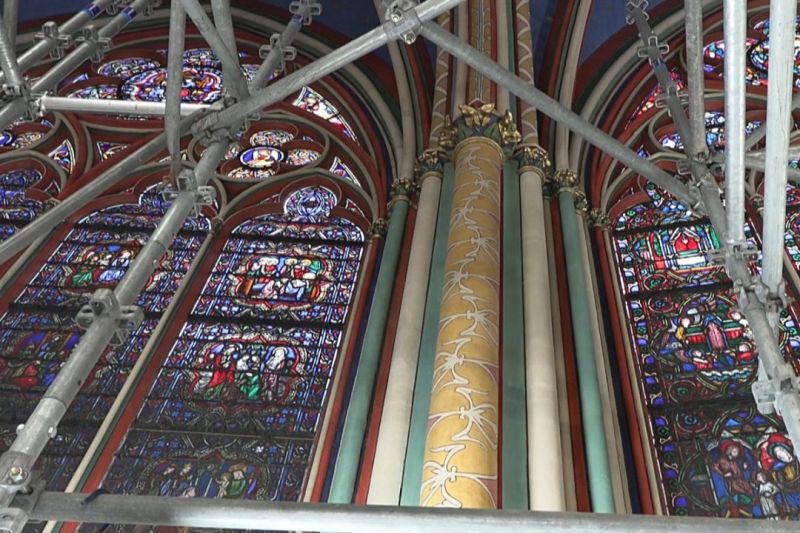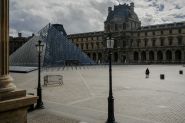
©Photo by Mathilde Bellenger/AFP
Four years after the devastating fire that ravaged Notre-Dame de Paris, the iconic Gothic cathedral has risen from its ashes, more resplendent than ever. On April 15, 2019, flames engulfed Notre-Dame de Paris, leaving behind a wounded edifice and a mourning country. Today, as the restoration project nears completion, visitors who step through the doors of Notre-Dame on December 8 will be captivated by the restored beauty of this Gothic art jewel.
 Photo by Mathilde Bellenger/AFP
Photo by Mathilde Bellenger/AFP
Upon entering one of the 24 fully restored chapels, the vice-rector of Notre-Dame, Guillaume Normand, cannot hide his wonder at the vibrant colors of the frescoes designed by Viollet-le-Duc in the 19th century. He exclaims, "It’s audaciously daring!" highlighting the bright hues and stylized patterns that adorn the walls. The natural light, filtering through the meticulously cleaned medieval stained glass, floods the building with striking clarity. Miraculously spared by the fire, these stained glasses, including the three large rosettes, diffuse their muted colors, enhancing the atmosphere of the place. A large golden cross and a statue of the Virgin and Child, found intact amid the debris, attest to the resilience of Notre-Dame in the face of adversity.
On the bustling construction site, workers are busy restoring the black and white checkered floors, while massive scaffolding still hides some of the restored treasures, such as the carved and painted wood of the choir enclosure. The rector of the cathedral, Monsignor Olivier Ribadeau-Dumas, promises an unparalleled experience to future visitors, evoking a sense of humility towards those who have created, transmitted and saved this exceptional edifice.
The redesigned visitor route, equipped with new signage, will lead visitors through the biblical history and the history of the saints who have marked Paris. They will also discover new liturgical furniture in bronze, combining simplicity and solidity. At the entrance, a polished bronze baptistery, topped with a golden lid mimicking the reflection of water, will welcome baptism ceremonies. The faithful will be able to sit on 1,500 to 2,000 openwork chairs facing a simplified central altar to attend mass. At the back of the cathedral, a tabernacle installed on an altar designed by Viollet-le-Duc will precede a contemporary "reliquary wall" housing the Crown of Thorns of Christ, brought back by Saint Louis. These elements reflect the restorers’ desire to combine respect for the past with a touch of modernity, to offer visitors a unique spiritual and aesthetic experience. As Notre-Dame prepares to welcome between 13 and 14 million visitors per year, or 40,000 to 45,000 people per day, it stands proudly as a symbol of the resilience and timeless beauty of Paris.
With AFP
 Photo by Mathilde Bellenger/AFP
Photo by Mathilde Bellenger/AFPUpon entering one of the 24 fully restored chapels, the vice-rector of Notre-Dame, Guillaume Normand, cannot hide his wonder at the vibrant colors of the frescoes designed by Viollet-le-Duc in the 19th century. He exclaims, "It’s audaciously daring!" highlighting the bright hues and stylized patterns that adorn the walls. The natural light, filtering through the meticulously cleaned medieval stained glass, floods the building with striking clarity. Miraculously spared by the fire, these stained glasses, including the three large rosettes, diffuse their muted colors, enhancing the atmosphere of the place. A large golden cross and a statue of the Virgin and Child, found intact amid the debris, attest to the resilience of Notre-Dame in the face of adversity.
On the bustling construction site, workers are busy restoring the black and white checkered floors, while massive scaffolding still hides some of the restored treasures, such as the carved and painted wood of the choir enclosure. The rector of the cathedral, Monsignor Olivier Ribadeau-Dumas, promises an unparalleled experience to future visitors, evoking a sense of humility towards those who have created, transmitted and saved this exceptional edifice.
The redesigned visitor route, equipped with new signage, will lead visitors through the biblical history and the history of the saints who have marked Paris. They will also discover new liturgical furniture in bronze, combining simplicity and solidity. At the entrance, a polished bronze baptistery, topped with a golden lid mimicking the reflection of water, will welcome baptism ceremonies. The faithful will be able to sit on 1,500 to 2,000 openwork chairs facing a simplified central altar to attend mass. At the back of the cathedral, a tabernacle installed on an altar designed by Viollet-le-Duc will precede a contemporary "reliquary wall" housing the Crown of Thorns of Christ, brought back by Saint Louis. These elements reflect the restorers’ desire to combine respect for the past with a touch of modernity, to offer visitors a unique spiritual and aesthetic experience. As Notre-Dame prepares to welcome between 13 and 14 million visitors per year, or 40,000 to 45,000 people per day, it stands proudly as a symbol of the resilience and timeless beauty of Paris.
With AFP
Read more





Comments